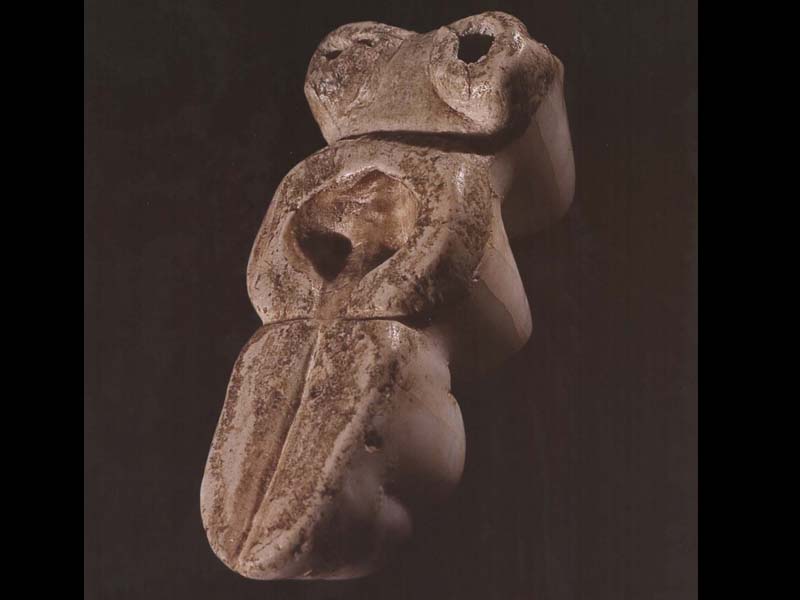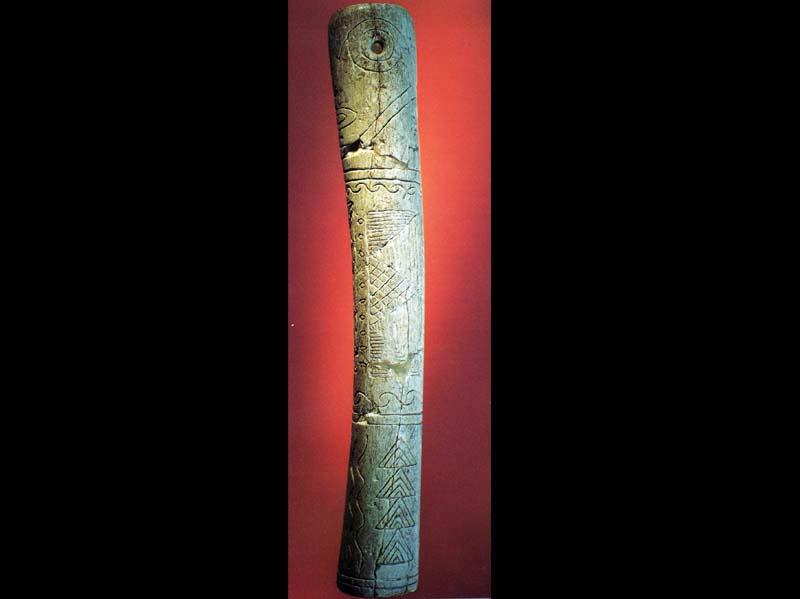It is a very particular female figure, found during the excavations of 1974, directed by Bernardo Bagolini, against the wall where the historiated wind instrument obtained from a human femur was found; it was made on a lower left boar molar, decorated on one side only, adapting the representation to the shape of the tooth.
In this regard M. Gimbutas writes: “… The magical bond between the boar and the Goddess is revealed by a statuette found in the Neolithic layer of the Gaban cave, in northern Italy, made from the lower third molar of a wild boar. The lower part of the tooth was used for the image. The section containing the roots was scraped clean, leaving a smooth surface but with some hollows and bumps, which became the uterus and sinuses. The figure recalls the type of statuettes - already described - that I call "rigid nude", in which arms and legs are brought together and the belly is emphasized. On the uterus are 13 engravings, perhaps a count of the lunar months in a year or the number of days of the waxing moon…” (M. Gimbutas, 2008). The decision to reproduce the figurine on a boar's tooth has a strong Mesolithic tradition, as does the detail of the dilated exposed vulva (as if it were connected to the birth posture), which is found in several examples of Paleolithic, Gravettian and Magdalenian figurines.
From the same layer comes a right human femur, masterfully manipulated to widen the medullary canal, decorated on the surface with geometric motifs divided horizontally into 3 sections: the upper part shows a human face with characteristics similar to anthropomorphic pebble, with eyes made with through holes; the middle and lower sectors are characterized by geometric decorations (triangles, zig-zags, chevrons and lozenges); each sector is separated by a recurring S-shaped frieze. Various hypotheses have been made on the functionality of the object, but the most plausible one is that it is a wind instrument; blowing into the upper hole, a sound corresponding to the G note is obtained, as was experimented at the Florence Conservatory. In this regard M. Gimbutas writes: “… This purported wind instrument is carved from the diaphysis of a right human femur and indicates the Bird Goddess' association with music. In the upper part there is a mask of the Owl Goddess with large round eyes; her eyes are two holes. The middle and lower sections are decorated with multiple chevron panels, striated triangles, bands of zig-zags and rhombuses, and wavy lines. The face portrayed on the mask has a long beak-shaped nose …” (M. Gimbutas, 2008).




Historical notes
Shelter Gaban is located in Piazzina di Martignano, in the northeastern suburbs of the city of Trento, on a flat area located under a natural rock ledge about 10 meters high, 6 meters deep and 60 meters long. The particular exposure, protected from the north winds, has favored the attendance of the site in the prehistoric age, attested with a certain continuity from the Mesolithic (7500 BC) to the Middle Bronze Age (1600 BC). The first surveys began in 1962 when the Director of the Local Museum of Uses and Customs Giuseppe Sebesta, intrigued by the ceramic finds that surfaced on site, carried out the first exploratory excavation without any results. The first real excavation campaign began only in 1970, under the direction of Bernardo Bagolini, then Director of the Prehistory section of the Museum of Natural Sciences, continued with annual campaigns until 1981, thanks to the availability of the site owner, Mr. Richetto Pasquali, nicknamed Gaban due to the fact that he loved to wear a "Gaban", a cloak, which therefore gave the name to the shelter. A covering structure was immediately built for the excavation area, thus allowing the setting up of a permanent construction site, which brought to light an imposing stratigraphic section of about 6,00 m still visible on site; it is noted that even today the basic level of the Mesolithic has not been reached. Between 1982 and 1985 the studies were carried out on the Mesolithic level, under the direction of Bernardo Bagolini, Alberto Broglio and Stephan Koslowski. Since 2007 the excavations have been under the direction of Annaluisa Pedrotti of the University of Trento, with the collaboration of Diego Angelucci and Fabio Cavulli. The excavated area is located close to the shelter, on a surface of about 60 m5, divided into XNUMX sectors; numerous art objects have been found, both in Mesolithic and early Neolithic deposits, thus making Riparo Gaban one of the main international reference sites for the study of the neolithization process, i.e. the transition from nomadic hunter-gatherer groups to sedentary groups of breeders-farmers.
CARD
LATEST PUBLISHED TEXTS
VISIT THE FACTSHEETS BY OBJECT

